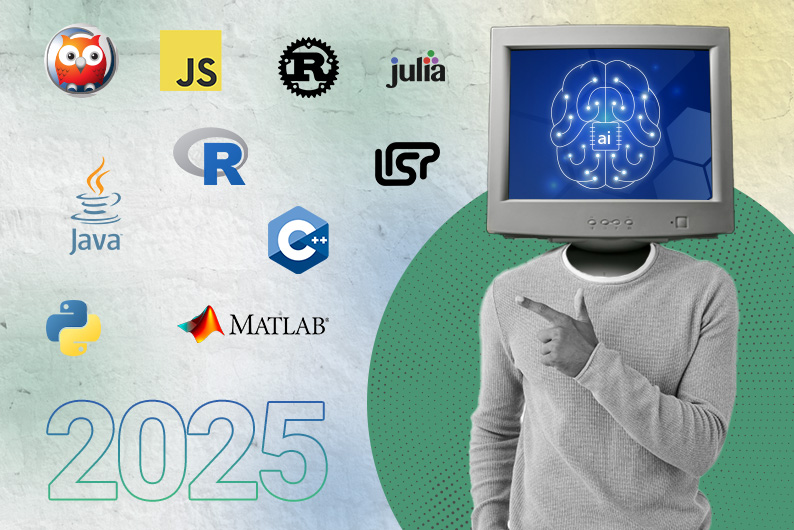AI is going to reinvent many industries and change how business is done in the digital space. As the years begin to go by, it will become necessary and relevant for developers and organizations in 2025 to seek the best programming languages for the diverse areas of Artificial Intelligence. From machine learning to natural language processing, robotics, and big data analytical tools, the AI programming language greatly influences project outcomes.
Those companies that are interested in the successful implementation of AI usually work with top-performing Software Development Company like Intellisource which will help to find a suitable approach in this sphere. Here we have a detailed analysis of the most popular AI programming languages of 2025 with the specification of their importance, uses, and imagination of why they continue or become popular AI languages.
1. Python: The Unchallenged Leader
Python has traditionally been the with driving AI development ahead of the curve and by 2025 there appears to be no let up. It is incredibly useful and has become part of nearly all modern web development, and with its strong support for libraries for AI, it is invaluable for AI projects.
Key Features of Python
- Ease of Learning and Use: Python’s rather clear syntax and fairly intuitive nature allow the creation of ideas by all levels of developers.
- Comprehensive Libraries: There are special libraries for nearly everything one might need when working with machine learning, deep learning, or data such as TensorFlow, PyTorch, Keras, Scikit-learn, and NumPy.
- Cross-Platform Support: Python can easily be run on different operating systems, thus providing for a multiplicity of operating options for their programs by developers.
- AI Community Support: Python seems uncomparably crowded with AI enthusiasts and experts; rich in resources, forums, and tutorials.
Top Applications
Python’s active usefulness is embodied in natural language processing (NLP), computer vision, predictive analytics, and top-shelf fields like autonomous vehicles. The intelligent application at the core of Intellisource showcases how Python has become the first choice for crafting stable and sector-specific AI tools.
2. R: The Data Scientist’s Favorite
R has its unique place in the AI world as the language that is mostly used for statistical calculations and creating visualizations. Despite the fact that R is not as widely used as Python it still cannot be left out of AI projects that require large amounts of data.
Key Features of R
- Statistical Excellence: R is best in handling statistics and statistical models and in performing tests and analysis of data.
- Visualization Power: Frameworks such as ggplot2 and shiny allow the developers to design eye-catching interfaces of big data.
- Integration with Big Data Tools: R can work with Hadoop/Spark giving the benefits of Big Data processing.
Top Applications
R is popular in fields like finance, healthcare, and the academic sector, where both statistical analysis and clean presentation of data are mandatory. For organizations aspiring to make big data answers, R will stay competitive in 2025.
3. Java: Reliable and Scalable
Java is a popular option among enterprises because Java is stable, predictable, and has excellent compatibility and scalability to deploy and embed AI into their systems.
Key Features of Java
- Platform Independence: This is chiefly due to Java's "write once, run anywhere" feature, which benefits program development for use on multiple platforms.
- Stability for Large Projects: Among the deployment platforms targeted by AI applications, Java is well adapted to designing large-scale AI applications for businesses.
- AI-Specific Frameworks: Different application programs ease the development of AI models and applications such as Deep learning.
Top Applications
Java is nowadays implemented in fraud detection systems, in network security tools, and in enterprise applications which have to be integrated with AI. For those companies interested in reliability and getting a very large number of users, Java remains one of the leaders in the AI field.
4. C++: The Powerhouse for High-Performance AI
Despite the emergence of improvements to date, C++ remains tenacious maintaining its status as a high-performance language suitable for large-scale AI applications, especially in time-sensitive and hardware-dependent environments.
Key Features of C++
- Unmatched Speed: Therefore C++ enables the developers to write very efficient code that makes it perfect for time-sensitive applications.
- Robust Memory Management: It has low-level control of memory and can be highly effective for specific hardware-targeted AI such as robotics.
- Flexibility for Algorithms: It gives specific possibilities for algorithm control, which is crucial in the AI field.
Top Applications
C++ is used in all types of autonomous systems, robotics, and gaming AI where timely execution is necessary at the same time. From real-time decision-making for robotics systems to computational simulations, high efficiency is deployed using C++.
5. Julia: The Rising Star
In AI programming languages Julia has emerged as a promising language due to its high-performance numerical computing and machine learning tasks. Key Features of Julia include its blazing speed, parallelism, and growing ecosystem.
Top Applications
In the field of scientific research, large-scale simulations, and finance as well the language is been increasingly used and evolved. Its capability to handle tough mathematical modeling makes it a strong contender for AI projects requiring high computational power.
6. JavaScript: AI in the Browser
JavaScript, which is mostly used for online development, is increasingly being used in AI programming, particularly for interactive and browser-based AI applications.
Important characteristics of JavaScript include:
- Real-Time Interactivity: JavaScript lets programmers use AI models right in web browsers.
- AI Frameworks: Frontend development can benefit from machine learning capabilities thanks to TensorFlow.js and Brain.js.
- Versatility: It is perfect for AI-driven web apps due to its capacity to design captivating, intuitive user interfaces.
Top Applications
AI-powered chatbots, recommendation systems, and interactive dashboards all make extensive use of JavaScript. Its function in fusing AI capabilities with frontend development guarantees a smooth user experience.
7. Prolog: Logic-Based AI
One of the earliest AI languages, Prolog is still useful for tasks that call for rule-based logic and symbolic reasoning. Prolog's main characteristics include:
- Logical Paradigm: Prolog is special for AI development since it can analyze logical assertions.
- Symbolic AI: Prolog is excellent at reasoning tasks and creating knowledge representation systems.
- Automation Support: A common feature in the development of automated planning systems.
Leading Applications
Expert systems, natural language processing, and automated decision-making tools all employ Prolog. Despite being specialized, it is still the language of choice for AI applications requiring a lot of reasoning.
8. LISP: The Pioneer
As one of the earliest languages used for AI, LISP continues to influence AI research with its adaptability and symbolic processing capabilities.
Key Features of LISP
- Dynamic Typing: Facilitates quick prototyping of AI systems.
- Symbolic Computing: Ideal for natural language understanding and knowledge representation.
- Rich History: Decades of development have built a robust ecosystem for LISP.
Top Applications
LISP is often used in academic research, robotics, and complex AI simulations. Its flexibility makes it a powerful tool for creating cutting-edge AI systems.
9. MATLAB: A Scientific Approach to AI
For AI applications needing a great deal of mathematical modeling and visualization, MATLAB is still widely used.
MATLAB's primary features include: • AI Toolboxes: Development is sped up by pre-built AI and ML toolboxes.
- Data Visualization: AI model outputs can be properly interpreted with the aid of excellent visualization tools.
- Hardware Integration: Perfect for real-time AI applications in industrial and technical settings.
Leading Applications
Signal processing, image recognition, and industrial automation all make extensive use of MATLAB. It is essential for scientific applications due to its accuracy and capacity to handle big datasets.
10. Rust: The New Frontier
Because of its emphasis on concurrency, efficiency, and safety, Rust is becoming more and more popular as an AI language. Important aspects of Rust include:
- Memory Safety: Rust's ownership concept ensures safer AI development by removing common issues.
- Support for concurrency: Makes it possible to handle complicated calculations effectively.
- Developing Libraries: TensorFlow Rust and Rusty Machine are two examples of libraries that are enhancing AI capabilities.
Leading Applications
For edge computing, Internet of Things devices, and AI applications needing high performance and security, including cybersecurity systems, Rust is a solid option.
Final Thoughts
In 2025, there will be a wide variety of AI programming language alternatives available, each suited to certain requirements and use situations. Because of their ease of use and statistical strength, languages like Python and R are widely used, but newer contenders like Julia and Rust are establishing themselves with better performance and cutting-edge capabilities.
Working with a reputable software development company, such as Intellisource, guarantees access to state-of-the-art resources and knowledge. Selecting the appropriate language and partner is essential for success when creating AI-powered web applications, constructing massive enterprise systems, or addressing scientific problems.
Stay ahead of the curve in the rapidly changing field of artificial intelligence by embracing the possibilities and utilizing the power of these languages.


 Previous blog
Previous blog



